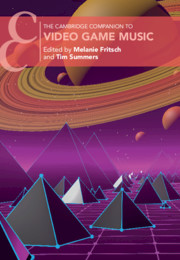Book contents
- The Cambridge Companion to Video Game Music
- Cambridge Companions to Music
- The Cambridge Companion to Video Game Music
- Copyright page
- Contents
- Figures
- Tables
- Musical Examples
- Contributors
- Preface
- A Landmark Timeline of Video Game Music
- Foreword: The Collaborative Art of Game Music
- Introduction
- Part I Chiptunes
- Part II Creating and Programming Game Music
- Part III Analytical Approaches to Video Game Music
- Part IV Realities, Perception and Psychology
- Part V Game Music, Contexts and Identities
- Part VI Beyond the Game
- 24 Producing Game Music Concerts
- Select Bibliography
- Index
- References
Part I - Chiptunes
Introduction
Published online by Cambridge University Press: 15 April 2021
- The Cambridge Companion to Video Game Music
- Cambridge Companions to Music
- The Cambridge Companion to Video Game Music
- Copyright page
- Contents
- Figures
- Tables
- Musical Examples
- Contributors
- Preface
- A Landmark Timeline of Video Game Music
- Foreword: The Collaborative Art of Game Music
- Introduction
- Part I Chiptunes
- Part II Creating and Programming Game Music
- Part III Analytical Approaches to Video Game Music
- Part IV Realities, Perception and Psychology
- Part V Game Music, Contexts and Identities
- Part VI Beyond the Game
- 24 Producing Game Music Concerts
- Select Bibliography
- Index
- References
Summary
And three ‘bips’ disrupted the silence – this is how a written history of game sound might start. These famous ‘bips’ in three different pitches occurred when players hit the white pixel representing the ball with the controllable white bar representing the bat, when the ball bumped from the upper or lower border or when the ball went off screen in the first widely commercially successful arcade game, Pong (1972). These sounds were not produced with a sound chip, but by the voltage peaks of the circuits in the gaming machine: in other words, their origin was analogue. Three years later, the arcade game Gun Fight (in Japan and Europe released under the name Western Gun), created by Tomohiro Nishikado, included a monophonic version of the famous opening bars of Chopin’s funeral march from his Second Piano Sonata, and was the first game to include a melodic line. Again three years later, Taito’s arcade title Space Invaders (1978), also created by Nishikado, used a changing soundtrack for the first time. It drew attention to the possibilities that a dynamic approach towards sound and music provided in terms of enhancing the player’s experience during play. The arcade cabinet produced its sounds using the Texas Instruments SN76477 sound chip that had come to market the same year. Such programmable sound generators (PSGs) were used to produce the sound and music for arcade titles, home consoles and home computers. Some of these chips came to fame, either as they were used widely and in many gaming devices, or because of their distinct sound, or both. Famous examples are General Instrument’s AY-3–8910 (1978), the MOS Technology 6581/8580 SID (Sound Interface Device; 1981) Atari’s POKEY (Pot Keyboard Integrated Circuit, 1982) and the Amiga Paula (1985). While these chips are usually referred to under one name as one item, it is worthwhile noting that many of them were produced in several iterations and versions. Another early approach towards game music beside the use of PSGs was wavetable synthesis, most famously adopted by Namco with their Namco WSG (Waveform Sound Generator) for their 8-bit arcade-game system boards such as the Namco Pac-Man board (1980) or the Namco Galaga board (1981). From the mid-1980s FM synthesis (Frequency Modulation Synthesis) was popular, particularly since the release of Yamaha’s DX7 synthesizer, and became the standard for game sound until the mid-1990s, with Yamaha being one of the main hardware producers. Unlike the PSGs, which used set soundwaves to give particular timbres, FM synthesis allowed waveforms to be blended and altered, giving rise to a far greater variety of timbres.
- Type
- Chapter
- Information
- The Cambridge Companion to Video Game Music , pp. 5 - 58Publisher: Cambridge University PressPrint publication year: 2021



